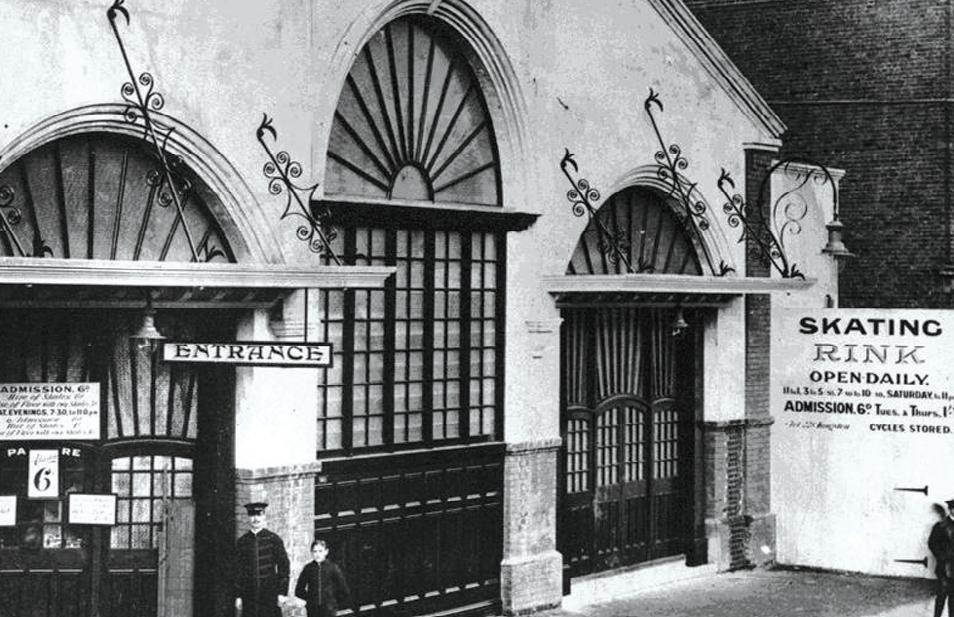
13 minute read
HISTORIC A/C 28
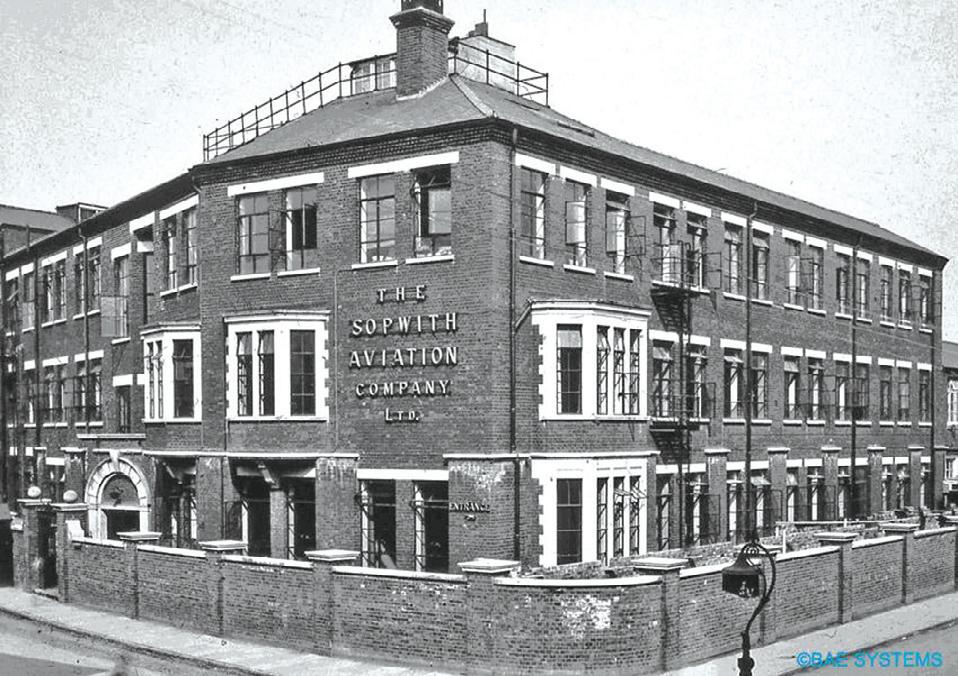
The Kingston Roller Skating rink in Canbury Park Road purchased by Tommy Sopwith became Sopwith Workshops number 1 in 1912.
Advertisement
Sopwith workers construct tabloid aircraft in the Number 1 workshops (formerly the Roller Skating Rink) in Canbury Park Road in Kingston. The historic Sopwith Office.


A Sopwith Baby floatplane seen prior to launching outside of another famous Kingston family manufacturers. The boat building facility of R.J. Turk’s & Sons who were involved with Sopwiths carrying out flotation tests on Sopwith aircraft at their Albany Boathouse river frontage near Canbury Gardens.
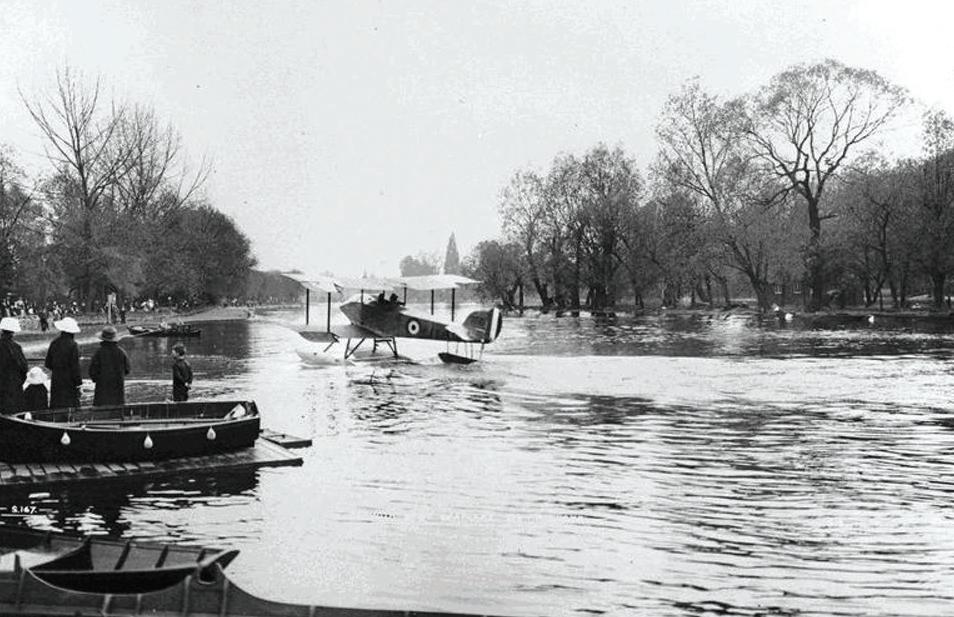
A Sopwith Baby is tested on the River Thames off Canbury Gardens in Kingston in 1916. This was one of an order of 100 for the Royal Navy, all were tested this way. Note the onlooking crowds on the riverbank in this spring scene.
Sopwith Camel – famous World War One fighter built in Kingston upon Thames. One was exhibited at Kingston’s Market Place as part of the Aviation Festival. It was first time a Sopwith Camel had been in Kingston since 1918. The façade of the former Hawkers/BAE manufacturing site in the Richmond Road, Kingston.

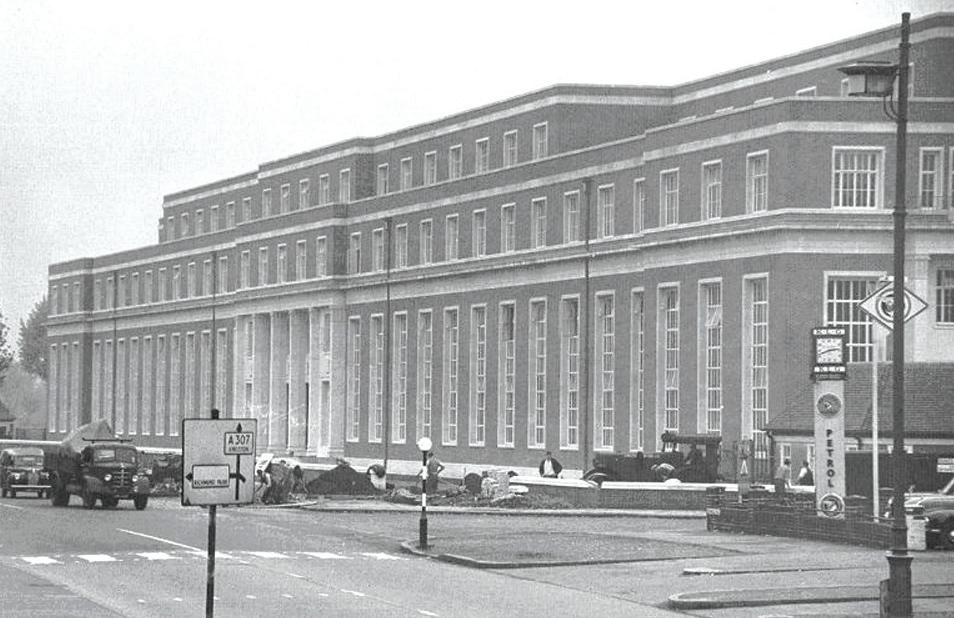
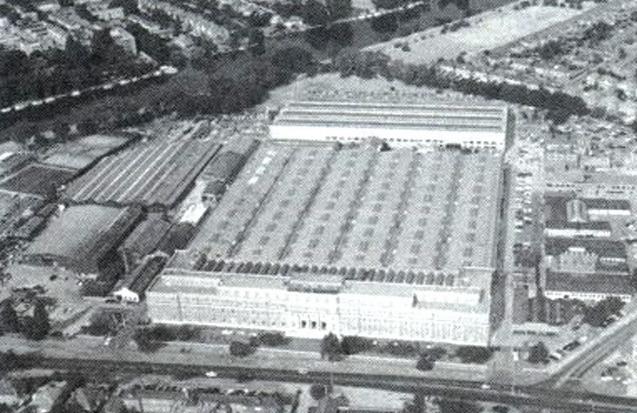
The famous Richmond Road Hawker’s riverside site (now demolished) where the Hawker aircraft including the Hurricane, Hunter and Harrier were developed and built. The BAe Hawk was the last all-British aircraft manufactured in Kingston and is still in service today, prominent among users are the RAF Display Team, the Red Arrows.

Brief History of Aviation in Kingston upon Thames
The History of Britain would be very different if Thomas Octave Sopwith (he was the 8th child) had not purchased the roller skating rink in Canbury Park Road near Kingston Railway Station South West London in December 1912. The Hawker Hurricane would not have been available to defeat the German Luffwaffe in the Battle of Britain and save the country from invasion. The Harrier Jump Jet would not have been available to shoot down the Argentinean jet fighter bombers over the Falkland Islands. Why did this aircraft designer want to buy a roller skating rink? It was because of the flatness of the roller rink’s surface. It was ideal for chalking out lines on the floor. In the early years of the aviation production planes were built to chalked out lines on the floor.
Sopwith was born in 1888 and started his aviation interest at the age of 18 by flying balloons. In 1910 he purchased his first heavier than air monoplane for £630 from Howard Wright. He flew solo for the first time on 22nd October 1910. A pioneering figure in aviation, he won the Baron de Forest prize in 1910 for flying across the English Channel. He later crashed the plane but he had caught the bug. He had a business idea of starting a flying school. He set up business at Brooklands aerodrome and racetrack, Weybridge, Surrey, England. One of his first pupils was Major Trenchard who later went on to run the Royal Air Force as Chief of Air Staff. Sopwith Charged £75 for a full course. Sopwith started to build aircraft at Brooklands. He built other designers aircraft under licence and the first Sopwith constructed aeroplane took off 4th July 1912. During the next six months his confidence as an aircraft manufacture increased and he decided to start designing his own planes. He needed a premises and that is when he found the Kingston Roller Skating Rink. The Skating craze had hit a high two years earlier and now was in decline so it was an ideal time for Sopwith to buy the premises. At the start he only had seven employees. Sopwith officially registered Sopwith Aviation as a company in 1913.
If you look at the former Sopwith factory’s location on a map it seems a strange place to locate an aircraft production facility. It was in the middle of a town and nowhere near an airfield.
Sopwith had foreseen that Float Planes were going to become important over the next decade and he needed a stretch of straight water to launch his designs. The River Thames just north of Kingston bridge was ideal.
Sopwith got in trouble from the River Thames Conservancy group and the local police as he ‘forgot’ to ask permission to use the river to launch his planes. He used to wheel his float planes down to the river very early in the morning when there were very few people around to avoid being caught. Sopwith purchased a large Daimler lorry to transport his land based planes to the nearby Brooklands airfield for testing. There are accounts that state he also towed some of his planes to Brooklands behind his car.
Sopwith Aviation made fighters and bombers for the Royal Flying Corps in World War One, like the famous Sopwith Pup and Sopwith Camel, and later for the RAF during the inter-war years and during World War Two. The Hawker Hurricane was developed in the Sopwith offices and built in Kingston upon Thames, Canbury Park Road near Kingston Railway Station.
The office building still remains but it has been turned into flats. All that remains of its historic past are small Hawker Hurricane propellers built into the wrought iron railings. This was where the first plans for the Hawker Siddeley Harrier jump-jet were drawn up.
The famous The Hurricane and The Harrier jump jet were constructed and developed at Hawker’s larger plant near the junction of Lower Ham Road with the Richmond Road on the outskirts of Kingston. From there, in the mid-1960’s Hawker's designer John Fozzard was put in charge of the development of the Harrier GR.1 After a long period of development the first Hawker Siddeley Harrier jump-jet flew on 31st August 1966. In 1977 Hawker Siddeley Ltd was nationalized and became part of British Aerospace (BAE) group. The ‘Hawker Siddeley Harrier’ then became the ‘BAE Harrier’. ■
AERIAL EUROPE

WORK MULTI MISSIONS • INTEGRATION • TECHNOLOGIES • SERVICES +44 208 255 4000 www.AvBuyer.com AUGUST 2022

AIR-TO-AIR PHOTOGRAPHY
The Flying Illustrators of Aerial Work Aviation
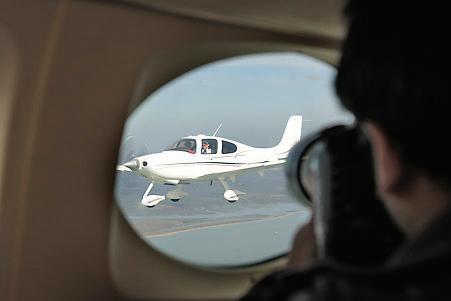
PHOTO COURTESY OF MARK WAGNER
Have you ever wondered how those sharp, close-up aerial photos of an aircraft get on the front covers of flying magazines? Or what it takes to make such awesome airborne images? If you want to know, Patrick Ryan will ‘autofocus’ you on to the answer!
Where Should We Start?
Let’s start by stating that professional Air-to-Air Photography is more than ending up with a fantastic picture of an aircraft slipping the surly bonds of Earth. It is thinking outside the box or outside the norm to create an image that catches the eye and captures the imagination. Yet, it also fulfills a customer’s needs even if that customer is a professional air-to-air photographer themselves.
Air-to-Air Photography is a small and very specialised Aerial Work aviation discipline or job that is used for specific purposes, including specific types of applications. In Aerial Work aviation, Air-to-Air Photography refers to capturing images or photographs of other aircraft or subjects from an elevated position for hire, i.e., from the position of another aircraft.
Air-to-Air Photography requires an artistic mindset and no shortage of technical skills. By far, aerial photographers have very specialised knowledge and experiences needed to successfully photograph flying aircraft while also being in the air themselves! Like other Aerial Work sectors, the Air-to-Air Photography sector has a narrow focus that requires a combination of airmanship skills and unique talents to achieve a specific purpose. In this case, it’s an airborne image.
So, What is ‘Air-to-Air Photography?’ What it is Not
Air-to-Air Photography is not Aerial Photography. Aerial photography, like Air-to-Air Photography, is the endeavor or effort of taking photographs or video images (i.e., Aerial Videography) from an aircraft, be it a manned or unmanned airborne platform. However, Aerial Photography typically refers to aircraft taking aerial images that focus on landscapes, earth surface objects, and man-made structures, i.e., air-to-ground vs. air-to-air.
Air-to-Air Photography, as a part of Aviation Photography, is the discipline of photographing aircraft or other flying objects by utilising another flying aircraft as a photo platform. Generally, it is two aircraft flying in formation. One carries the photographer and is called the ‘photo’ airplane; the second aircraft is the ‘subject.’
Concerning Air-to-Air Videography, Air-to-Air Videography or Air-to-Air Filming is embedded or parallel to Air-to-Air Photography. Air-to-Air Videography has the same objective and operating processes as Air-to-Air Photography, but the camera and some artistic methods and techniques are slightly different.
The Need for Speed!
When it comes to who needs an image of a fast-flying aircraft, the customer base can vary from a private person, multi-billion dollar corporation, or even a military air force. Air-to-air photographers or service providers seek to provide Air-to-Air Photography or Videography services to individuals, aircraft owners, media outlets, museums, and aircraft manufacturers. These end-users recognise the value of aesthetic images and the value it provides them personally or their companies economically.
Some of today’s primary (or sought-after) applications or services the Air to Air Photography community support are: Marketing & Advertising – People or companies who are in the process of marketing & advertising aircraft or aviation services rely on air-to-air photographers to enhance the marketability of their products or operations by showing it them in a dynamic ‘natural’ environment, i.e., flying.
Companies like Airbus, Cirrus, Bell Helicopter, etc., routinely use air-to-air photographs or videos for corporate, product, or branding campaigns. Additionally, many private aircraft owners also leverage air-to-air photography to enhance the saleability of their private or corporate aircraft. Media & Publishing – Besides marketing & advertising, many media outlets depend on air-to-air photographs or videos to enhance the message they are communicating. For example, many aviation publishing organizations or magazines like AvBuyer, Flying, Air Classics, Pilot, etc., regularly use inflight images of aircraft on the cover and throughout their magazines to capture their viewership.
Additionally, aerial images of aircraft are used in the publication of corporate reports, academic articles, and historical documentaries. Plus, you'll find air-to-air images on the internet, e.g., on blogs, YouTube, and many other social media platforms. Recording & Documentation – As well as marketing & publishing, air-to-air photographs and video helps document and "for the record" specific flying events like flight testing, training, and inflight emergencies.
Specifically, these air-to-air photography operations are conducted by ‘Chase Planes’ or ‘Chase Aircraft’. A chase plane flight operation is an aircraft that ‘chases’ a ‘subject’ aircraft or other types of flying objects to make real-time evidence observations by taking photographs and video of the subject platform. Private & Personal – Last but not least, various private and corporate aircraft owners want air-to-air photos for personal or private use. More private aircraft owners, flying clubs, and corporate flight departments enjoy seeing themselves flying their beloved aircraft or capturing the beauty and prestige of their investment. "Tips & Techniques" Rationale
As mentioned before, Air-to-Air Photography is a very specialised Aerial Work aviation discipline. Because of the complexity and skill of choreographing aircraft, managing cameras, and looking for the right photo setting, the pool of professional air-to-air photographers is small compared to the broader aviation photography community. However, when taking a fantastic photo or video of a flying aircraft, there are some common practices the true professional airto-air photographer applies. The following are just some of these practices: Plan, Plan, Plan! Air-to-Air Photography isn’t something that happens spontaneously or lightly. Air-to-air photo shots require detailed and extensive planning. When two aircraft hook up successfully in formation for a successful photo shoot, numerous hours are spent on ensuring every detail was thought through. The overall process consists of countless e-mails, phone calls, studying charts, weather checks, crew briefs between the photographer and pilots, and meticulously researching and cross-checking the flight formation plan to ensure the photo shot is safe and effective.
The photo-shot planning begins when the customer defines their requirements and needs. Some of these needs could be highlighting a new aircraft colour or design scheme, capturing a dynamic frontal image of a single airplane or formation of aircraft, or taking shots of an aircraft at low level over dramatic terrain in a high-G turn.
Following this, an air-to-air photographer will define the operating area and airspace and ensure both the subject and photo aircraft can operate within their technical limits. Most air-to-air photographers will say planning is the most critical part of taking a good shot. Without proper planning, the shot will never happen. Photo Aircraft & Configuration When it comes to aircraft, air-to-air photographers like to use traditional ‘photo aircraft’ to capture the right image of a ‘subject aircraft’. Therefore, aircraft with superb uninterrupted views from the rear or an excellent side-onangle look are preferred. Some aircraft used for Air-to-Air Photography are Cessna Caravans, Beech Bonanza, Shorts Skyvan, and even classic warbirds like the B-25 Mitchell and OV-10 Bronco for their rear ‘tail-gunner’ views.
Regarding configuration, the top two things air-to-air photographers are concerned with are plexiglass and safety. As many know, taking a picture through an airplane window is not the best. As a result, the quality or sharpness of the photo usually comes out poor. To mitigate this, many air-to-air photographers coordinate having a hatch or window removed for their photoshoots. Besides this, photographers fit safety harnesses to themselves and their kit, i.e., they would hate to lose their life or parts of their high-value camera equipment during an unscheduled wake turbulence event.
Inflight Photography Techniques As you can imagine, photographing other aircraft in the air has unique photographic challenges. It is a very fluid and dynamic environment with both the subject aircraft and the photo aircraft in high-speed motion against a continually moving ‘best-shot’ background. To manage all of this, airto-air photographers use many techniques to get it right first time.
The number one technique is managing lighting and the background. The lighting and the background are essential to getting the best photos. Proper lighting is achieved through relative positioning of the aircraft relative to the sun or by only flying at a specific time of the day as required. Additionally, photographers need to ensure both aircraft are placed in the best light and have non-competing backgrounds.
Besides considering lighting and background conditions plus the photo aircraft configuration, air-to-air photographers have to account for many other variables. For example: Propellers – When photographing propeller aircraft, photographers must consider the blur effect caused by the subject aircraft. Depending on the goal of the shot, the photographer will use a very high shutter speed to help ensure the sharpness of the subject and eliminate propeller spin blur. Conversely, slow shutter speeds often cause blurry subjects,i.e., because of the motion of the camera and aircraft.
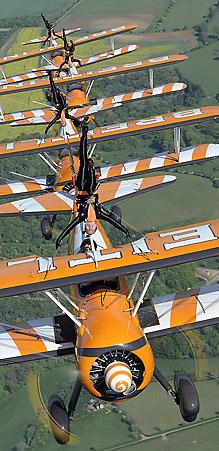
Stabilisation – Stabilisation is critical in getting any sharp image. Handholding a camera while standing firmly on the ground using certain shutter speeds is difficult. However, handholding a camera while shooting from a moving aircraft with a strong gale coming through the window with the subject airplane flying against a fast-moving background is even more challenging. Many air-to-air photographers use a gyro-stabiliser to mitigate this situation to dampen motion and aircraft vibration. A gyrostabiliser is a platform or device that dampens movement and vibration. Ever since the introduction of gyro-stabilisers, this bit of equipment has made air-to-air photography at slow shutter speeds possible.

The Coolest Job Ever!
The air-to-air photographerss job is a risky but rush-inducing kind of aerial photography that requires shooting from an aircraft with no doors or hanging out of windows. Air-to-Air Photography is definitely not for the faint of stomach. These photographers are comfortable with the idea of slipping out of their seatbelts, hanging out of hatches or open windows while completely turning around in their seats to get the right angle and perspective.
Along with this, air-to-air photographers routinely battle crazy conditions and the elements while flying in all aircraft types, e.g., frigid air, prop/rotor blast, defeating noise, ❯

